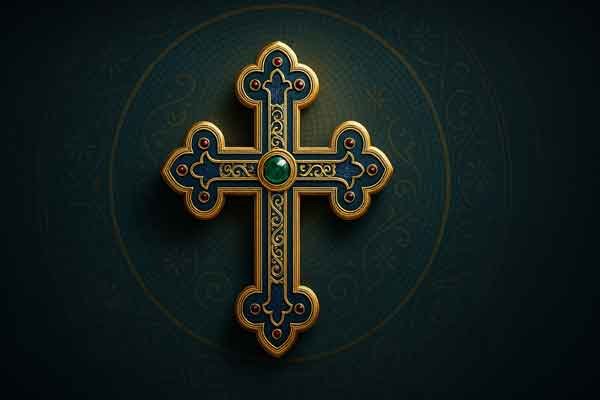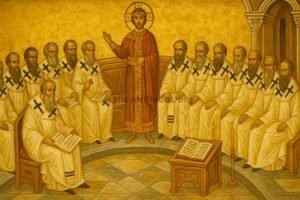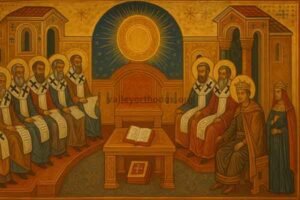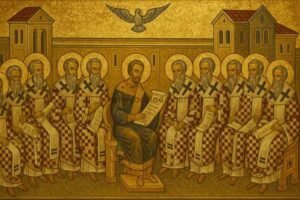The Byzantine cross is more than a shape; it is a language of faith, traced in gold and enamel, carried in procession, and worn close to the heart. From imperial Constantinople to village chapels, its many forms—budded, gemmed, multi-bar, reliquary—tell a continuous story about how Christians in the Byzantine world saw God, the Church, and themselves. This guide explains where the Byzantine cross comes from, what its variations mean, how it was crafted, and why it still matters today.
Origins & Theology of the Byzantine Cross

From Imperial Sign to Sacred Symbol
The cross in the Byzantine world crystallized after Constantine’s legalization of Christianity (4th c.). Once a sign of Christ’s victory over death, it also became an emblem of a Christian empire. Processional crosses crowned military standards and civic ceremonies alike, yet their meaning remained fundamentally liturgical: the cross points to the Paschal mystery—death and resurrection—at the center of worship.
Incarnation, Victory, and the Theology of the Cross
Byzantine devotion holds together two truths: the cross reveals Christ’s self-emptying love, and it proclaims His triumph over death. This is why Eastern imagery often emphasizes a radiant, jeweled cross (crux gemmata): the instrument of death is transfigured into a sign of glory. In homilies, hymnography, and iconography, the cross participates in what it proclaims—salvation and sanctification.
Forms and Variations
Greek, Latin, and Byzantine Conventions
- Greek Cross (four equal arms): Common in Eastern designs, emphasizing harmony and the four corners of the world.
- Latin Cross (longer vertical arm): More associated with the West but present across Christendom.
- Byzantine Conventions: Tend to favor balanced or subtly elongated forms, often enriched with buds, jewels, inscriptions, and additional bars.
Budded (Trefoil) and Gemmed Crosses (Crux Gemmata)
- Budded/Trefoil Ends: Three rounded terminals on each arm reference the Trinity and new life. The budding suggests flourishing—faith that grows and bears fruit.
- Crux Gemmata: Crosses ornamented with gems or glass cabochons. Jewels signify glory and the “preciousness” of redemption; light refracting through enamel and stones evokes the transfiguring light of Christ.
Patriarchal & Multi-Bar Crosses
- Patriarchal Cross (double-bar): The upper, shorter bar represents the titulus (“INRI”) placed above Christ’s head; the lower, longer bar is the main beam.
- Three-bar variants: Appear in some Eastern traditions, with symbolic readings (e.g., the lowest slanted footrest, or suppedaneum, pointing to the Good Thief’s salvation).
- Processional & Altar Crosses: Often larger, with sockets for poles or stands, designed to be seen in movement and from a distance.
Reliquary and Processional Crosses
- Reliquary Cross (Enkolpion): Hollow pectoral crosses opening to contain relics or fragments of the True Cross. Carried by clergy, monastics, and sometimes laity, they integrated personal devotion with the Church’s sacramental life.
- Processional Cross: Mounted on staffs, these led liturgies inside churches and in outdoor rites—epitomizing the cross as the Church’s banner.
Craft, Materials, and Techniques
Goldsmithing, Filigree, and Gem Setting
Byzantine artisans worked in gold and silver, using filigree (soldered wire patterns), granulation (tiny gold beads), and bezel settings for gemstones (garnet, sapphire, pearls). Metal surfaces were frequently inscribed with doxologies (“IC XC NIKA,” “Jesus Christ conquers”) or invocations seeking blessing and protection.
Enamel (Cloisonné) and Court Workshops
Cloisonné enamel—thin gold cells filled with colored glass paste and fired—produced bright, jewel-like surfaces. Court and monastic workshops standardized motifs: crosses framed by vine scrolls, angels, or saints; pectoral crosses with medallions of Christ and the Theotokos; and altar crosses studded with enamel roundels.
Inscriptions, Blessings, and Protective Motifs
Short prayers (“Κύριε ἐλέησον,” “Lord, have mercy”), Trinitarian formulas, and Psalmic phrases appear on cross arms and backs. Protective motifs—rosettes, stars, vine-scrolls—echo biblical imagery of life and light. The result is a theological object in miniature: a cross you can “read.”
Liturgy and Devotion
Processions, Blessings, and Feast Days
The cross organizes time and space in Byzantine worship. On feasts like the Exaltation of the Holy Cross, clergy elevate and venerate the cross; processions mark the sanctification of the city and the faithful. Processional crosses bless water, fields, and homes, extending the Church’s prayer into daily life.
Pectoral Crosses for Clergy and Laity
Clergy traditionally wear pectoral crosses as a sign of office; laity adopt simpler pectorals for personal devotion. In both cases, the cross is not merely ornament—it is a confession of faith, a portable remembrance of baptism and the Eucharist.
Icons and the Cross: Seeing and Venerating
Icons frequently embed crosses—on halos, vestments, Gospel books—reminding worshipers that all sacred seeing is cruciform. The veneration of icons and the veneration of the cross share the same logic: honor passes to the prototype, not to matter as such.
Regional Styles & Legacy
Constantinople’s Influence Across the Mediterranean
Imperial and monastic ateliers in Constantinople set the stylistic benchmark for altar, processional, and pectoral crosses. Their metalwork—gold or silver with filigree, cloisonné enamel, and gem settings—spread via trade, diplomacy, and pilgrimage. Workshops in the Aegean, Asia Minor, and parts of Italy adopted these models, retaining balanced proportions, budded (trefoil) terminals, and concise invocations (e.g., IC XC NIKA).
Balkans and Slavic Adaptations
As Byzantine Christianity expanded, local workshops blended Constantinopolitan patterns with regional aesthetics. Balkan and Slavic pieces often favor sturdier proportions, cooler or more restricted enamel palettes, and inscriptions in Greek and/or Church Slavonic. Multi-bar crosses (a shorter titulus bar and, in some traditions, a slanted footrest) become more prominent, while enkolpion (reliquary) pectorals remain a consistent thread of personal devotion.
Contemporary Devotion: Orthodox Cross Necklaces
Today’s pectoral and personal crosses continue this lineage. Clergy crosses signify office; lay crosses serve as a daily confession of faith. Common features include trefoil ends, compact inscriptions (IC XC NIKA), enamel roundels, and occasional gemstone settings echoing historical crux gemmata. Materials typically include sterling silver or gold; cords or chains vary by custom. For a concise overview of forms and symbolism in everyday wear, see the Orthodox cross necklace guide. Often blessed and worn close to the heart, these are devotional objects first—linking modern practice to a millennium of Byzantine tradition.
The Byzantine Cross Today
Devotional Jewelry and Personal Piety
Modern pectoral crosses continue the tradition of faith worn near the heart. Many designs consciously echo Byzantine precedents: trefoil buds, enamel roundels, and gemmed centers. When chosen thoughtfully, a cross becomes a small catechism—form preaching meaning.
Museums, Replicas, and Responsible Sourcing
Historic pieces reside in museum collections; contemporary artisans create reverent replicas. Buyers should look for responsible sourcing (ethical metals, transparent gemstone provenance) and workmanship that honors the cross’s sacred purpose rather than treating it as mere fashion.
Key Takeaways
- Form teaches theology. Buds, bars, gems, and inscriptions are not decoration first; they’re doctrine in metal and light.
- Craft serves devotion. Enamel, filigree, and gemstone setting are historical ways of honoring the mystery the cross proclaims.
- Continuity matters. Today’s crosses consciously receive, interpret, and carry forward Byzantine traditions in liturgy and daily life.
FAQs
What is a Byzantine cross?
A family of cross forms used in the Byzantine (Eastern Roman) world, often featuring trefoil buds, gemstones or enamel, and—at times—multiple bars, all expressing the cross as both sacrifice and victory.
Why do some Byzantine crosses have two or three bars?
The shorter upper bar symbolizes the titulus above Christ; additional bars (including a slanted footrest) carry theological and liturgical meanings rooted in Eastern tradition.
What does the budded (trefoil) design mean?
The three rounded ends reference the Trinity and symbolize life and growth—faith flowering from the cross.
What is a reliquary (enkolpion) cross?
A hollow pectoral cross that carries relics (sometimes a fragment of the True Cross). It unites personal devotion with the Church’s veneration of saints.
How did Byzantine artisans make such vivid colors?
Through cloisonné enamel—fusing colored glass within gold cells—and by setting reflective stones that catch and magnify light.


